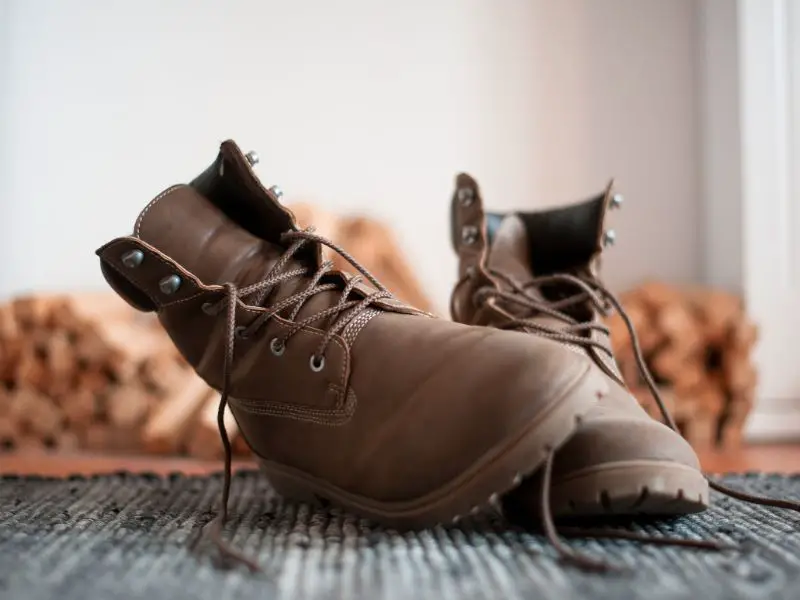There’s been a recent trend of more people wearing boots in the gym. You may wonder, “does wearing boots while lifting give you an advantage?” “Is it ok to workout in boots?” Or you may have just forgotten to pack your tennis shoes, and all you have is boots.
Whatever brought you here, we have an answer for you in this article. By the time you leave, you’ll know if you should workout in boots. We’ll also walk you through considerations you should make about footwear in the gym. Let’s get started.
Is It Safe to Workout in Boots?
It is generally considered safe to workout in boots. Combat boots, hiking boots, or ones designed for weightlifting should work well. That said, be aware of grip if you wear boots on surfaces they weren’t designed for. Slippery gym floors may cause problems for certain types of boots.
Pros and Cons of Working Out in Boots: What You Need to Consider
So we know that working out in boots is generally safe. That said, you should still consider the pros and cons before deciding if boots are best for your training.
Pros of Lifting in Boots
The advantages of lifting in boots are:
- Boots may provide extra foot stability and support.
- Many boots have an elevated heel which some may prefer for squats.
- Boots provide an extra protective layer that could help if you drop a weight on your foot.
- Boots are sturdy and usually made for doing real work.
- If you wear boots during the day, you won’t have to change shoes before going to the gym.
- Boots may be more visually appealing than tennis shoes.
Cons of Liting in Boots
The disadvantages of lifting in boots are:
- Boots are less flexible, they won’t have the bend and give needed for certain exercises.
- They can make deadlifts, lunges, and calf raises harder.
- You should probably avoid doing cardio in boots. Several studies have shown how improper footwear can lead to running or cardio-related injuries.
- Boots can be harder on your feet.
- Boots can make your feet sweat more while working out.
- Some boots may slip more on smooth commercial gym surfaces.
As you can tell from this pros and cons list, the effectiveness of boots in the gym is debatable. They aren’t necessarily a bad option, but other types of footwear may be better suited for working out.
Types of Boots Suitable for Working Out: What to Look For
If you want to wear boots while lifting, certain types will be more suitable for training. Here are the four best options if you want to wear boots while lifting.
Combat Boots
Combat boots are the top choice if you want to wear boots in the gym. We know combat boots work because military servicemen and women wear them all the time when training. Combat boots are built for all types of surfaces and conditions. They’re more flexible than other boots and should perform well in the gym.
Hiking Boots
Hiking boots are also a good option. The purpose of hiking boots is to hold up when traveling for miles over uneven terrain. They should handle a commercial gym workout without any problems. If you use hiking boots while working out, pick ones with smoother soles. Many have very rugged soles that may hold you back when working out.
Doc Martens
Doc Martens can also be a decent option for working out. One consideration to keep in mind is Doc Martens are often designed more for fashion. That makes them less capable of doing heavy work. That said, some Doc Martens are designed more for work and less for style. Those are the ones I’d aim to get.
Lifting Boots
Lifting boots designed specifically for the gym are also a good option. They will hold up great on commercial gym floors and during big lifts. The downfall is you might only want to wear them in the gym. You can tell by looking at them they’re meant for lifting. So it depends if you think it’s worth the cost to buy shoes you’ll only wear when working out.
Lifting Shoes vs. Boots: Which Is Better for Your Workout?
Some people may be debating if buying lifting shoes or boots will be better for their workouts. This is common with those who are considering a shoe with an elevated heel for squats. Many people hope boots could be a workaround to avoid investing in shoes specifically for the gym. The following comparison chart will show you which performs best in important categories.
| Important Considerations | Lifting Shoes | Boots |
| Comfort | ✓ | |
| Grip on Commercial Gym Floors | ✓ | |
| Flexibility | ✓ | |
| Can Wear Them for Other Activities | ✓ | |
| Price | ✓ | |
| Durability | ✓ | ✓ |
| Designed for Working Out | ✓ |
Ultimately, whether you choose lifting shoes or boots will depend on personal preference.
Lifting shoes are designed for weightlifting. They will be the most comfortable, flexible, and grip the best on commercial gym floors.
Boots are the better everyday option. They tend to be more affordable, you can wear them for other things, and they still hold up in terms of durability.
Footwear to Avoid When Lifting Weights: What Not to Wear to the Gym
Boots are a decent option, but there is still footwear you should avoid wearing to the gym. You should avoid wearing:
- Flip flops
- Sandles
- Crocs
- Dress shoes
- Boots that are designed for fashion
These types of shoes won’t give you the grip or support that is needed for lifting weights.
Characteristics of Footwear to Avoid
Some characteristics of shoes that you should avoid lifting in are:
- Avoid shoes that have slippery soles. Slipping while lifting can be a hazard and could cause injury.
- Avoid open-toed shoes. Most open-toed shoes don’t provide enough support. They also leave your feet more vulnerable if you happen to drop something on them.
- Don’t lift in shoes that are too big or too small. Improperly sized shoes can cause blisters or lead to rolled ankles from poor support.
- Don’t wear shoes that you want to keep looking nice. Gyms can get dirty and messy. Plus, going all out can put more wear and tear on your shoes. Avoid working out in shoes you like to wear on special occasions.
With all these things considered, you should have a good idea of the proper footwear for lifting.
The Importance of Proper Footwear: A Brief History of Weightlifting Footwear
Throughout modern history, proper footwear has always been important when lifting weights.
First, let’s start during the early days of modern lifting between 1920-1950. Most weightlifters during this time wore either regular tennis shoes or boxing shoes. There weren’t many variations in footwear between these years.
The 1960s was when we first started seeing new developments in weightlifting footwear. The emergence of split squats and other new lifts brought forth this change. Here, we saw new developments to make boxing shoes more sturdy and lifters wearing work boots.
Up until the 1970s, most shoes used for lifting had been high tops. This changed with the development of new weightlifting shoes from Adidas that had a low top and elevated heel. You still see a similar lifting shoe design from Adidas to this day.
From the 1980s – present day, we’ve seen weightlifting shoes modernized. Many have stayed consistent with the original Adidas design. The elevated heel helps those who have their heels come off the ground while squatting. We’ve also seen flat shoes for deadlifts and boots designed specifically for weightlifting hit the market.
As you can see, people have been lifting in boots since the 1960s. Wearing boots while lifting isn’t a new concept; it’s been around for some time. It’s usually considered time-tested, safe practice to workout in boots.
Conclusion: Should You Work Out in Boots? Here’s What You Need to Know
Ultimately, the answer to whether you should workout in boots is – it depends. Yes, we hate giving that answer. But it is the case here.
The only advantage that boots might give you is an elevated heel that will make you feel better while squatting. That said, plenty of weightlifting shoes are designed to do that. Weightlifting shoes are also better suited for performance in commercial gyms.
If you want to wear boots, try them out and see if you like working out in them. Wearing them won’t hurt you at all. If you like them and they’ll keep you returning to the gym, wear boots. The most important thing is to do whatever keeps you training consistently.
FAQs about Working Out in Boots: Your Questions Answered
Resources:
- Best Pull Up Bar Diameter For You: A Comprehensive Guide - September 4, 2023
- Grip Talk: What is Barbell Knurling & Why It Matters? - September 4, 2023
- Say Goodbye to Shoulder Pain: How to Avoid Pain from Dips - September 4, 2023

